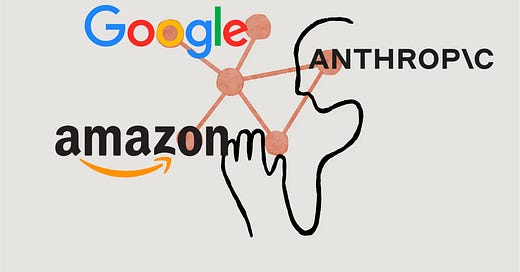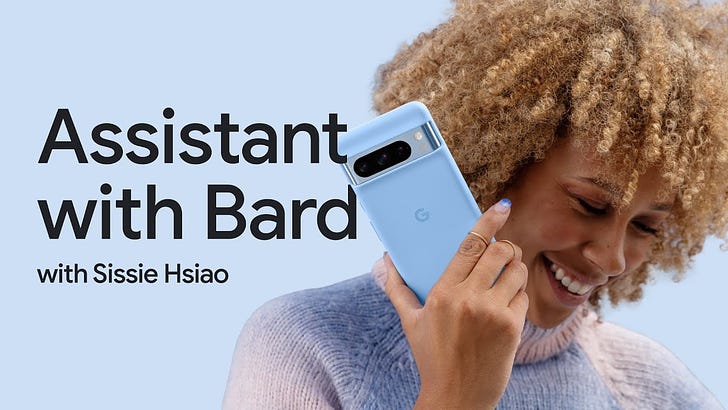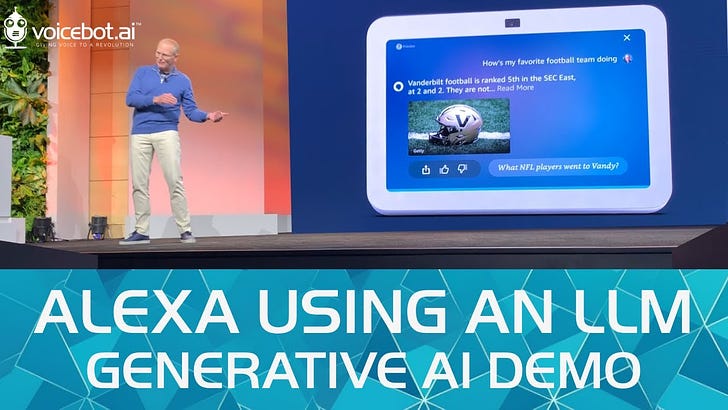Anthropic Secures $2 Billion in New Funding from Google
Anthropic emerges as the primary OpenAI alternative among proprietary LLMs
The Wall Street Journal reported that Google has agreed to provide another $2 billion in funding to Anthropic. This news emerged just four weeks after Amazon agreed to invest up to $4 billion in the startup large language model (LLM) provider. According to the The Wall Street Journal’s (N.B. paywall) Berber Jin and Miles Kruppa:
Google invested $500 million upfront into the OpenAI rival and agreed to add $1.5 billion more over time, people familiar with the matter said. The investment follows a separate commitment Amazon made last month to invest $4 billion in the company, which was founded by former OpenAI engineers in 2021 with the goal of developing rival generative AI models.
Google, owned by parent company Alphabet, already invested $550 million in Anthropic earlier this year.
Who is the Bigger Shareholder?
The Wall Street Journal and others previously reported that Amazon has agreed to commit $1.25 billion now and max out at $4 billion at some future date. It appears that Google’s $550 million in two earlier rounds of investment were coupled with another $500 million now. That may bring its total investment to just over $2.5 billion.
However, $4 billion from Amazon may not represent a greater ownership stake than $2.5 billion from Google. Since Google invested in at least two earlier funding rounds, it is reasonable to assume Anthropic’s valuation was lower at the time. Google may have exercised pro-rata investment rights to match Amazon’s ownership or ensure it was not a smaller shareholder than its tech giant rival.
The Cloud Wars
This is not Google’s and Amazon’s first battle on the leading-edge AI front. Amazon Alexa carved out a lead in the voice assistant market by bringing the technology into homes and providing an alternative to cars. Google played the fast-follower with Google Assistant. Both companies cooled on voice assistants in recent years as e-commerce and software subscription revenue did not follow rapid consumer adoption. More recently, both Amazon and Google have announced generative AI upgrades to Alexa and the Assistant, respectively.
Anthropic represents an investment in an entirely different market. While Alexa and Google Assistant are adding generative AI as an application feature, Anthropic’s generative AI foundation model is designed to be the engine behind thousands of applications. Alexa and Google Assistant were driven primarily by the companies’ devices and services segments. The Anthropic investment is driven by the Amazon Web Services (AWS) and Google Cloud computing divisions.
Both Amazon and Google have their own LLMs. However, Amazon Titan and Google PaLM have not captured as much enthusiasm among enterprise cloud computing customers as OpenAI’s GPT model family, which is currently exclusive to Azure among the leading cloud providers.
AWS and Google Cloud need to have a compelling alternative to OpenAI to prevent their current customers from testing out Azure simpley to get access to a preferred LLM. I was told about a company this week that had tried out Azure for the first time for this reason alone. A trial can easily lead to shifting other computing and data storage workloads over to a rival cloud provider.
This is not a theoretical risk. Microsoft’s 2024 Q1 earnings call this week revealed that there are currently 18,000 companies using Azure OpenAI Service, up from 11,000 in July, and 4,500 in May. CNBC reported that Azure’s growth exceeded analyst expectations by 3%. It also reported that Microsoft’s CFO Amy Hood said around three percentage points of the quarter’s Azure growth was tied to AI, beating the earlier forecast of two percentage points.
The Primary Alternative
OpenAI has been first to market and first to enthusiasm across the generative AI spectrum. GPT-3 in 2020 captured a lot of interest and ultimately led to several new software companies basing their businesses on the technology. OpenAI’s DALL-E carved out a leading position (subsequently lost to the open-source Stable Diffusion model) in the AI image generative segment. ChatGPT in late 2022 and GPT-4 in the first quarter of 2023 took this market lead to a new level.
OpenAI has been first to market and first to enthusiasm across the generative AI spectrum…Amazon’s and Google’s investments are likely to have the second-order effect of making Anthropic the primary OpenAI alternative, a self-fulfilling prophecy. They have invested heavily in the company and will benefit if it emerges as a comparable rival to OpenAI. Others have seen that vote of confidence and will treat Anthropic accordingly.
OpenAI has become the default LLM for many organizations that want to experiment with generative AI or feel compelled to bring the new technology capabilities quickly into production. While Google’s PaLM is generally viewed as very capable and likely somewhere between OpenAI’s GPT-3.5 and GPT-4 in performance for many use cases, Google was caught unready to bring its generative AI capabilities to market when interest unexpectedly ignited following ChatGPT’s release.
Amazon was also caught off guard and had not planned to launch its own Titan LLM this year. Initially, Amazon thought it would provide LLM access through its Sagemaker service targeted at data scientists. The rapid market shift led AWS to launch Amazon Bedrock earlier this year, which is designed to provide access to all of the LLMs that are not from OpenAI.
There are other proprietary LLMs, such as AI21 Labs and Cohere, both of which are available through AWS and Google Cloud and are generally viewed as very capable. And there is Meta’s Llama 2 which is an open model also available through the cloud providers and has generated a lot of interest. However, Anthropic has something none of the other companies offer.
Anthropic’s 100,000 token context window means that it can handle 3-12 times more in-memory context than rival LLMs. That means it is the only LLM that can support use cases with large context window requirements. It also has shown its ChatGPT alternative, Claude 2, is highly capable.
That differentiation was enough for Amazon and Google to tap Anthropic as its pick for the primary alternative to OpenAI. This is not to say that Google will not continue to promote PaLM and its upcoming Gemini foundation model, nor that Amazon will abandon Titan or cease to offer access to other LLMs through Bedrock and Sagemaker. Instead, both companies want to present their cloud customers with a compelling LLM that has a capability OpenAI cannot claim.
In addition, Amazon’s investment was likely influenced by an intent to keep Google from owning all of this rival LLM. Google’s new investment, similarly, may be motivated by not wanting Amazon to start exerting more control over Anthropic, or risk losing the start-up’s earlier commitment to spend more than $3 billion with Google Cloud for model training.
Amazon’s and Google’s investments are likely to have the second-order effect of making Anthropic the primary OpenAI alternative, a self-fulfilling prophecy. They have invested heavily in the company and will benefit if it emerges as a comparable rival to OpenAI. Others have seen that vote of confidence and will treat Anthropic accordingly.
The potential downside of such positioning is if Anthropic falls out of favor with its cloud suitors and the LLM love triangle disintegrates.
This explicit endorsement should help drive market adoption momentum and provide Anthropic with strong promoters at two of the three leading cloud hyperscalers. Since most of the production generative AI solutions will be run in these clouds, it may even offer Anthropic a long-term market structure advantage over OpenAI. The potential downside of such positioning is if Anthropic falls out of favor with its cloud suitors and the LLM love triangle disintegrates.
The Impact on AWS
The biggest loser in this announcement is Amazon. It hoped to deflect some of Google’s technology advantages and influence over Anthropic as an early and large investor. More importantly, Amazon saw Anthropic as a means to create market confidence in its AI-optimized ASICs and position them as alternatives to NVIDIA’s GPUs for foundation model training and inference. Amazon’s announcement said:
Anthropic will use AWS Trainium and Inferentia chips to build, train, and deploy its future foundation models, benefitting from the price, performance, scale, and security of AWS. The two companies will also collaborate in the development of future Trainium and Inferentia technology.
AWS will become Anthropic’s primary cloud provider for mission critical workloads, including safety research and future foundation model development. Anthropic plans to run the majority of its workloads on AWS, further providing Anthropic with the advanced technology of the world’s leading cloud provider.
It is unclear how Google’s $3 billion cloud computing commitment from Anthropic will impact these agreements. Anthropic is walking a tightrope between two giants that are accustomed to getting their way. It has market momentum, a big pile of cash, more cash on the way, and a path to market leadership—provided it can effectively juggle these relationships.
All of the incentives generally align among the parties today. They all want to stop OpenAI from taking a dominant position. Amazon and Google want this to ensure Microsoft doesn’t transform its ownership stake in OpenAI into a larger share of the cloud computing market. As long as Anthropic’s success continues to serve these ends, all should be well. If interests diverge, however, that could undermine the entire strategy.
Amazon Reshuffles LLM Ecosystems with an [up to] $4B Investment in Anthropic
Amazon will invest up to $4 billion in Anthropic and have a minority ownership position in the company. Anthropic and Amazon announced a new partnership today that includes the former committing to running its primary training and inference workloads on AWS, and the latter investing “up to $4 billion,” for a minority stake in the company. There is a lot …
Amazon Alexa Gets Generative AI Makeover and Explores New Use Cases for Consumers
“I often say that Alexa is the best personal AI out there, but I will tell you, it's always been a little bit more transactional than we would like, but that is a limit of the technology, not the vision. And thanks to our latest LLM, you can now have a near humanlike conversation with Alexa.” - Dave Limp, SVP of Amazon Devices






![Amazon Reshuffles LLM Ecosystems with an [up to] $4B Investment in Anthropic](https://substackcdn.com/image/fetch/$s_!MyW6!,w_1300,h_650,c_fill,f_auto,q_auto:good,fl_progressive:steep,g_auto/https%3A%2F%2Fsubstack-post-media.s3.amazonaws.com%2Fpublic%2Fimages%2Fee28339c-609f-42e9-8986-b05928518712_1920x1080.jpeg)

